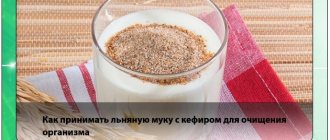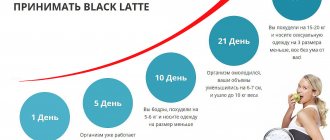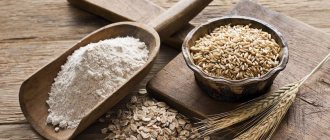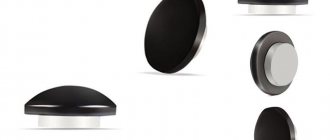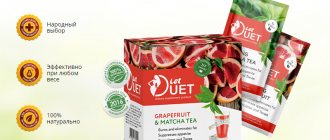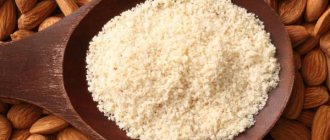Buckwheat
This is a flour that many recommend using for weight loss, despite its calorie content and high glycemic index. This is due to the fact that it contains no gluten at all, which:
- provokes severe allergic reactions;
- causes inflammation with further formation of edema and joint pain;
- and most importantly, it disrupts the functioning of the gastrointestinal tract, which forces the body to store everything that has not been digested in reserve in the form of fat depots.
Gluten is found in wheat, oatmeal, barley and rye. As a binding component, it forms dough of the required viscosity for baking. But buckwheat does not contain it, which allows it to be used in diets.
Distinctive features:
- grey colour;
- specific taste;
- the dough turns out dense and steep;
- There is only one variety, but it is produced under different brands.
Secrets of use: for baking, it is better to mix it in equal proportions with wheat.
When preparing what dietary dishes can you use:
- pancakes;
- dumplings (provided they contain low-calorie poultry);
- bread;
- pies (preferably with vegetable filling).
Considering that buckwheat flour is hypoallergenic and also lowers blood sugar (which also promotes weight loss), it is not surprising that it is considered one of the healthiest. If you are going to go on a diet, it is better to choose this for delicious baked goods.
Which is the most useful
The complete absence of flour with proper nutrition is a misconception that has been refuted by nutritionists for a long time. They simply emphasize that flour products should have a low calorie content, a low glycemic index, and should be rich in substances beneficial to humans.
List of calories
The calorie content of foods differs from the glycemic index. Calorie content indicates how much energy the human body receives after breaking down a certain product. The Glycemic Index (GI) is a ranking that ranks foods that raise blood glucose levels the fastest.
For a person, high blood glucose levels are a bad indicator that the body is predisposed to diabetes. The lower the GI of a product, the better; there is a dependence of the GI level on the composition of the product - the amount of sugars and fiber.
| Name | kcal | proteins g | fat g | carbohydrates g | glycemic index |
| Buckwheat | 353 | 13,6 | 1,2 | 71,9 | 54 |
| Pea | 298 | 21 | 2 | 49 | 35 |
| Corn | 331 | 7,2 | 1,5 | 72,1 | 70 |
| Linen | 270 | 36 | 10 | 9 | 35 |
| Oatmeal | 369 | 13 | 6,8 | 64,9 | 69 |
| Rye | 294 | 10,07 | 1,9 | 58,5 | 40 |
| Rice | 366 | 5,95 | 1,42 | 77,73 | 95 |
| Soy | 291 | 48,9 | 1 | 21,7 | 15 — 25 |
| Barley | 284 | 10 | 1,6 | 56,1 | 45 |
Which honey is healthier - you can find out HERE!
Corn
Many believe that the healthiest flour not only for weight loss, but also for health in general is corn flour. And this opinion is not unfounded. It, like buckwheat, does not contain gluten, but is rich in vitamins A, E, group B and many microelements (iron, potassium, phosphorus, calcium, magnesium, etc.).
Distinctive features:
- There are three varieties: fine and coarse grinding, wallpaper;
- yellow or white;
- sweetish taste;
- meadow smell;
- Baking from it does not have any fluffiness.
Secrets of use: for the dishes to be successful, you must add oil. Considering the process of losing weight, it is better to give preference to olive, but not creamy. Can be mixed with wheat and rye.
When preparing what dietary dishes can you use:
- flatbreads;
- casserole;
- syrniki.
For a long time, corn flour was treated with prejudice (it is inexpensive, accessible mainly to the poor, and the baked goods are not as fluffy as we would like). But time put everything in its place. This product improves digestion, promotes the flow of bile and normalizes the functioning of the heart and blood vessels.
However, those who use glycemic diets for weight loss should take into account the high GI of this product.
Video: Is it possible to have flour on a diet? Types of healthy flour
Chickpeas
100 g of flour contains 360 kcal. Glycemic index – 35. Made from chickpeas – Turkish peas. The flour has a pleasant taste and a yellowish tint. Baking made from it is very satisfying and smells like nuts. Suitable for making bread, flatbreads, cookies, pasta. Flour contains a lot of dietary fiber, fiber, vegetable protein, vitamins and microelements - iron, potassium, copper, selenium, calcium, phosphorus, sodium. Chickpea flour is certainly effective in weight loss because it has beneficial dietary qualities.
Barley
100 g of flour contains 284 kcal. Glycemic index – 45. It is made from crushed barley grains. The flour is gray in color and has no smell or taste. It contains vitamin A, D, E, PP and microelements - calcium, phosphorus, sulfur, manganese, sodium, folic acid and fluorine. Flour helps strengthen the entire body, muscle growth, strengthening bone and cartilage tissue. Due to the fact that this flour contains a large amount of gluten, it is not possible to cook anything from it alone. It is mixed with other flours to make flatbreads, pancakes, breads and pancakes.
Amaranth
100 g of flour contains 357 kcal. Glycemic index – 25. Amaranth is a herbaceous plant native to Mexico. Its flowers are small, and the edible part of the plant is the seeds. They are used in cooking. Flour is a powerful antioxidant without gluten in the composition. There are practically no fats, but, on the contrary, there is a lot of calcium in it. If you consume flour regularly, you can remove excess cholesterol from the body and normalize blood pressure. This is a useful flour for weight loss. You can use it to make baked goods, pancakes, crackers, and also add it to pilaf, porridge and sauce.
Soy
100 g of flour contains 386 kcal. Glycemic index – 15. It is prepared from fried beans. Soy is a rich source of plant-based protein, vitamin B, iron and calcium. Along with weight loss, consuming soy flour will reduce blood cholesterol and the risk of developing cardiovascular diseases and cancer. For women, this flour is especially useful because it helps alleviate the symptoms of menopause and menopause. You can make pies, buns, cakes, pancakes, muffins, and pasta from soy flour. By the way, in terms of composition and properties, 1 tbsp. l. soy flour can replace 1 chicken egg.
Pea
100 g of flour contains 298 kcal. Glycemic index – 30. It is prepared from pea fruits. This flour contains a lot of vitamins A, B, C, E and PP and microelements - zinc, calcium, phosphorus, magnesium, fluorine, cobalt, chromium, pantothenic acid and fiber. The flour also contains amino acids, pyridoxine, lysine and trionine.
It can be consumed by people suffering from obesity, diabetes, stomach diseases and tuberculosis. You can use it to make donuts, cookies, crackers, bread, cereals, purees, or add it to meatballs or cutlets. You can even choose pea flour for making dumplings for weight loss.
Chestnut
100 g of flour contains 245 kcal. Glycemic index – 65. It is produced from chestnut fruits. Interestingly, chestnut flour is a good substitute for wheat flour. It tastes sweet. Free of gluten and high fat content. But this flour contains a lot of magnesium, potassium and phosphorus. In terms of nutritional value, dishes made from it are close to dishes made from potatoes and rice. Suitable for making bread, muffins, pancakes and castagnaccio (Italian pie).
Lentil
100 g of flour contains 321 kcal. Glycemic index - 25. It is produced from lentils - plants from the legume family. Flour is rich in vitamins A, B, E, PP, iron, magnesium, folic acid, sulfur, potassium, calcium, phosphorus, zinc, silicon, fluorine and sodium. Regular consumption of lentil flour will help strengthen the cardiovascular system, improve metabolism, and reduce cholesterol and blood sugar. It is suitable for making bread, pancakes, flatbreads, pancakes, cookies, and adding to purees and vegetable soups.
Sesame
100 g of flour contains 462 kcal. The glycemic index is 35. It is made from sesame seeds or cake, but the flour has the same beneficial properties as the whole seed. It tastes like nuts. Flour contains many fatty acids - stearic, arachidic, palmitic, myristic, oleic and linoleic. There is no gluten in the composition, but there is more than enough calcium. Flour helps remove toxins from the body and promote muscle growth. It prevents the occurrence and development of gastrointestinal diseases. Very useful after periods of depression and stressful situations. The flour is suitable for making halva, bread, rolls, muffins and cookies. It is added to salads and sauces, and it is also used to bread fish or meat.
Rice
Rice flour will be especially useful for losing weight, if at the same time you need to cleanse the body and remove excess fluid from the tissues. It contains a lot of thiamine and riboflavin, and also half as much fat as, for example, wheat (if you take the highest grade). Gluten free.
Distinctive features:
- The white variety has a neutral taste and does not overwhelm other foods in dishes, but the whole grain variety has a clearly noticeable nutty note;
- no smell;
- a large amount of starch and a minimum of fiber are among its most significant disadvantages;
- makes dishes crispy.
Secrets of use: mix with other varieties in a 4:1 ratio, and also add more water.
When preparing what dietary dishes can you use:
- bread;
- flatbreads;
- bread;
- cookie;
- sauces (as a thickener).
Rice baked goods fit perfectly into oriental and cleansing diets.
Sesame flour
Sesame seeds are used to make the most valuable food product - sesame flour, which has a pleasant nutty taste and aroma. It contains various amino acids, including tryptophan, necessary for the production of seratonin - the hormone of happiness, vitamins (E, T, group B), many macro- and microelements, antioxidants, pectins, fiber.
Glycemic index
| Name | Squirrels | Fats | Carbohydrates | Calories | Glycemic index (GI) |
| Sesame flour | 45 | 12 | 31 | 412 | 57 |
Advantages and disadvantages
The benefits of sesame flour are due, first of all, to its beneficial composition. It saturates the body with a huge amount of vitamins, microelements and amino acids of plant origin. Sesame flour contains large quantities of fiber, which is necessary to activate gastrointestinal peristalsis and stimulate the process of cleansing the body and removing toxins.
However, despite all the benefits, there are also contraindications. Doctors do not recommend eating sesame flour for people with thrombosis or varicose veins, since this food additive thickens the blood.
Where is it used?
In the culinary world, sesame flour is commonly used as a breading for cutlets, added to baked goods, and added to sauces and gravies as a thickening agent. Due to the pronounced benefits of the product and medicinal properties, it is also used in medicine. Sesame flour is an effective herbal medicine for the treatment of gastrointestinal diseases. In addition, it has a beneficial effect in the treatment of acne and dermatitis.
Recipe with sesame flour
Chocolate cookies
Ingredients:
- cocoa powder - 35 g;
- wheat flour - 200 gr;
- sesame flour - 1 tbsp;
- eggs - 2 pcs;
- milk - 150 ml;
- dry yeast - 3 g;
- salt, sugar, spices - to taste.
Recipe:
- mix cocoa and milk in a saucepan, add sesame flour, heat the mixture over low heat, without bringing to a boil;
- In a separate bowl, beat two eggs with a whisk, combine with the milk mixture and all dry ingredients;
- mix thoroughly until smooth, put the dough in a warm place for half an hour to let it rise;
- roll out the dough into a thin layer with a rolling pin and cut out round pieces using a glass;
- place them on a baking sheet greased with butter (butter or coconut), bake at a temperature of 180-190 degrees for about 15-20 minutes.
Oatmeal
It will allow you to withstand even the most restrictive diet, as it increases the production of the joy hormone - serotonin. It blocks hunger pangs and helps overcome stress, which is often the main cause of excess weight.
Distinctive features:
- refers to products with a low percentage of starch and gluten, which makes it even more useful for weight loss;
- At the same time, it contains a lot of fat, so you shouldn’t get carried away with dishes made from it;
- makes baked goods crumbly and airy.
Secrets of use: it is better to mix it with other types of flour in a ratio of 1:3. If you have a powerful blender at home, you don’t have to buy it separately: just grind regular oats into powder.
When preparing what dietary dishes can you use:
- pancakes;
- flatbreads;
- cookie;
- pancakes.
The amino acid composition of oatmeal resembles muscle protein, so it will be most useful for those who use not only diets, but also workouts to lose weight. Contains vitamins A, E, group B, microelements, dietary fiber, fiber.
Video: Elena Malysheva. Corn flour
Almond
100 g of flour contains 602 kcal. Glycemic index – 25. It is made from dried almond pulp. The composition contains iron, phosphorus, potassium, magnesium, sulfur, calcium, beta-carotene, choline, saturated fatty acids, antioxidants and phytoestrogens. There is gluten in the composition, but in a minimal amount. Almond flour saturates the human body with nutrients and protein, helps improve vision and anemia, and also has a positive effect on the functioning of the reproductive system of women. Heat treatment does not reduce the beneficial properties of flour. And thanks to its ability to absorb and retain moisture, baked goods remain fresh for a longer time. The flour is suitable for making confectionery products - cakes, biscuits, sweets and nut cream.
Wheat bran
100 g of flour contains 208 kcal. Glycemic index - 65. It is a storehouse of vitamins A, B, E, H and minerals - magnesium, calcium, phosphorus, sodium, silicon, iron, selenium, copper, zinc, nickel and molybdenum. Wheat-bran flour has great benefits for the human body. It improves the functioning of the gastrointestinal tract, promotes the elimination of harmful substances and weight loss. This flour is also an excellent preventative against atherosclerosis, diabetes and allergic reactions. You can use it to make bread, pancakes, pies or pancakes.
Rye
To correct your figure during training, it is better to use rye flour because it contains lysine. This is an amino acid that is actively used by athletes during intense physical activity. It reduces fat stores while increasing energy expenditure. Controls the level of bad cholesterol in the blood. Stimulates lipolysis, promotes stress resistance, improves endurance.
Distinctive features:
- divided into 3 varieties: seeded, wallpaper, peeled;
- has a dark color;
- the dough turns out sticky and dense, the baked goods have a strong taste and smell, and are not beautiful to look at.
Secrets of use: it is recommended to combine with wheat flour in equal proportions.
When preparing what dietary dishes can you use: bread, any unsweetened pastries.
If you are planning to lose weight without excluding flour products from your diet, be sure to use rye flour. But at the same time, take into account contraindications to its use: a tendency to flatulence, recent surgical operations, gluten intolerance and exacerbation of gastrointestinal diseases.
Table of nutritional value (BJU) and calorie content per 100 g of product
Thanks to this table, every person losing weight will be able to choose the healthiest type of flour for themselves. It is enough just to study it in detail.
| Product | Calorie content | Squirrels | Fats | Carbohydrates |
| Baranki | 312 | 10,4 | 1,3 | 68,7 |
| Buckwheat core | 329 | 12,6 | 2,6 | 68 |
| Buckwheat done | 326 | 9,5 | 1,9 | 72,2 |
| Hercules | 355 | 13,1 | 6,2 | 65,7 |
| Corn | 325 | 8,3 | 1,2 | 75 |
| Manna | 326 | 11,3 | 0,7 | 73,3 |
| Premium wheat flour | 327 | 10,3 | 0,9 | 74,2 |
| Wheat flour, grade I | 329 | 10,6 | 1,3 | 73,2 |
| Wheat flour, grade II | 328 | 11,7 | 1,8 | 70,8 |
| Rye flour | 326 | 6,9 | 1,1 | 76,9 |
| Oatmeal | 345 | 11,9 | 5,8 | 65,4 |
| Pearl barley | 324 | 9,3 | 1,1 | 73,7 |
| Millet | 334 | 12 | 2,9 | 69,3 |
| Wheat "Poltavskaya" | 325 | 12,7 | 1,1 | 70,6 |
| Rice | 323 | 7 | 0,6 | 73,7 |
| Butter pastries | 297 | 7,6 | 4,5 | 60 |
| Drying | 330 | 11 | 1,3 | 73 |
| Wheat crackers | 331 | 11,2 | 1,4 | 72,4 |
| Cream crackers | 397 | 8,5 | 10,6 | 71,3 |
| Oatmeal | 357 | 12,2 | 5,8 | 68,3 |
| Rye bread | 214 | 4,7 | 0,7 | 49,8 |
| Millet bread. from grade I flour | 254 | 7,7 | 2,4 | 53,4 |
| Barley | 322 | 10,4 | 1,3 | 71,7 |
Based on the data indicated in the table, there will be no problems with choosing flour that will help you get rid of extra pounds. And you can be glad that while on a diet, you don’t have to give up your favorite baked goods. It’s just that the best flour for weight loss will be used to prepare it, even if it’s not familiar at the time of starting the diet, and not the usual wheat flour. But this does not mean at all that the taste of pancakes or pancakes will change for the worse.
Starch and its beneficial effects on the body
Starch is a white powdery substance without taste or odor. It is isolated from starchy plants . For example, rice, soybeans, wheat, corn, potatoes, sweet potatoes, lentils, peas, etc.
The most popular types are corn and potato starch powder. Its main purpose is thickening , as it swells well in hot water.
The chemical composition of starch does not differ in a wide variety of vitamins and microelements. However, it still has some beneficial effects on the human body:
- Starch contains the vitamin niacin , one of the most important regulators of oxidative and reduction processes in the body. Hormonal levels, tissue regeneration, successful burning of calories, etc. depend on it.
- The composition of starch powder includes phosphorus , calcium , potassium , sodium .
- This product affects the production of riboflavin and vitamin B2 . They are important for establishing proper metabolism.
- Due to its soft and sticky physical form, starch is recommended for people with stomach ulcers . Enveloping its walls, it has an anti-inflammatory and analgesic effect.
- Starch is used as a flour substitute in case of gluten allergy.
- During digestion, it turns into glucose . Therefore, it is recommended to be used by people experiencing great physical or mental stress as a source of additional energy.
Flour and its benefits for humans
Flour is a food product that is made by grinding raw cereal grains : wheat, rye, buckwheat, spelt, oats, corn, rice, millet. The bulk is extracted from wheat. The remaining types are produced in smaller quantities and used in traditional dishes of national cuisines.
Depending on the degree of grinding, the mixture of ground wheat grain is divided into different grades, namely grit, premium, first, second grade and wallpaper:
- Krupchatka is a coarse flour variety that is characterized by graininess.
- High-grade (baking) flour differs from others in its low gluten and snow-white color.
- First grade flour is universal and is used in cooking. It is characterized by a higher gluten content. Therefore, this dough is easy to give the desired shape, it is fluffy and does not become stale for a long time.
- The second variety is darker in color due to the presence of bran.
- Wallpaper flour is a product consisting entirely of crushed grain shells.
Flour varieties have different ratios of beneficial microelements and vitamins. The coarser the grind, the more essential substances are retained in the composition. However, all species without exception are characterized by the presence of the following components that have a beneficial effect on the human body:
- Flour contains a large amount of nutrients : iron, potassium, magnesium, copper, calcium, zinc, phosphorus, sodium, selenium, manganese. They ensure the proper functioning of internal organs.
- Wheat flour contains fat-soluble vitamins E and K B vitamins , namely B1, B2, B3, B4, B5, B6 and B9.
- Flour powder is rich in fiber , which promotes successful digestion and absorption of food, and also normalizes cholesterol and glucose levels in the blood.
- Flour made from durum wheat stimulates the hormone serotonin , which is responsible for a good mood.
- Flour contains gluten , which helps in the production of red blood cells and increases the oxygen saturation of the body.
- Flour products are a rich source of energy .
Flour and starch as indispensable helpers in the kitchen
Flour and starch have a long history of use in cooking. They are common organic ingredients that are added to gravies, batters, sauces, and breadings. They also serve as the basis for the production of bakery and confectionery products, dumplings, pasta, etc.
These components are used by almost all housewives to prepare daily dishes. But not every one of them knows what benefit or harm they cause to the health of their family members.
A little about wheat flour
Experts disagree about the benefits and harms of this type of flour. Many people believe that it does much more harm than good. Although there are many varieties of wheat flour, regardless of them, eating this product leads to weight gain, which in turn affects physical condition. The culprit for this is gluten, or more precisely gluten - its protein derivative, which can provoke diseases.
If you regularly consume products made from premium flour, there is a high risk of developing celiac disease. This is what people call gluten intolerance. And people suffering from diabetes should generally remove high-grade flour from their diet, as it is a source of many calories.
The “universal” first grade, which contains only 8 to 11 percent gluten, can be considered more or less safe. And spelled seems to be the most digestible of the wheat varieties as dietary flour. It is made from wheat germ, which is rich in protein and contains nutritional fiber.
The structure of spelled proteins is somewhat different, they are absorbed by the body faster and do not cause allergies, so it can be recommended for both diabetics and allergy sufferers suffering from gluten intolerance.
Among the beneficial aspects of wheat flour, there is a large amount of mineral and vitamin substances, due to which this product in small quantities is useful both for appearance (hair, skin, nails) and for the rhythmic functioning of internal organs and the nervous system.

